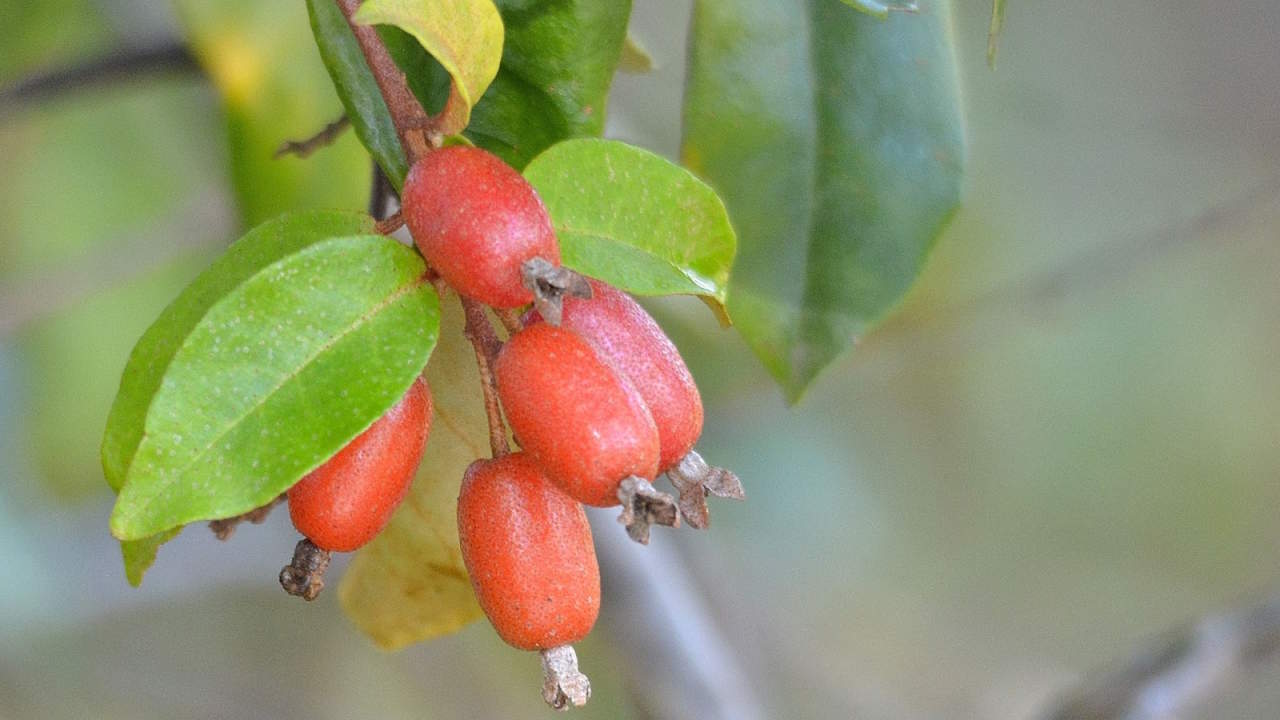Millaa Millaa
Elaeagnus triflora
Millaa Millaa is a tropical scrambling shrub or climber that produces red edible fruits also used in Aboriginal medicine as a treatment for dysentery. The plant takes its name from the region of Millaa Millaa in the Atherton Tablelands of Far North Queensland, where it grows prolifically around the trees. Beyond this region, you can find it occurring naturally in tropical rainforests and swamp forests from Cape York to Rockhampton in Queensland, as well as among thickets and scrublands up to 1500m above sea level.
Millaa Millaa fruits are small and elongated, similar in appearance to a kumquat but reddish in colour with a speckled rind. They’re sweet and tangy with a flavour that suits both sweet and savoury dishes. Add them fresh to fruit salads or use them in jams, jellies, muffins, fruit pies, savoury sauces, or infused teas and alcohols. Fruits are extremely rich in the antioxidant lycopene, which has potential applications in the prevention and treatment of cancer and other diseases. The single seed contained inside is also edible when cooked, offering a nutty flavour.
Flowering commences in Spring, starting with clusters of small, fragrant, white, star-shaped flowers growing on slender, sandpapery branches. These flowers attract many species of beneficial insects throughout the season, then produce tiny green fruits from just before Summer, ripening until the early Autumn. To harvest, pluck the fruits straight off the vine.
Millaa Millaa grows well in both full sun and dappled shade. Although it’s a tropical species that thrives on heat and moisture, it requires a soil with good drainage and is remarkably drought tolerant and slightly frost tolerant once established. For a good harvest, however, ensure it gets plenty of sunshine and regular watering during the fruiting season.
Millaa Millaa’s leathery leaves range from dull to bright green depending on the amount of light they get while growing. The underside of the leaves are copper or silver in colour with a metallic sheen. As it’s a climbing vine, Millaa Millaa loves a trellis and is suitable for fences, archways or as a decorative addition to fruit orchards. Upward growth can reach heights of up to 5m, with older stems becoming thorny to help hold the plant in place. Alternatively, you can train it as a bush or shrub with regular pruning and shaping.
Aboriginal name:
- Millaa Millaa (Mamu)
Is it true Millaa Millaa will make my fruit trees grow better?
This plant has a symbiotic relationship with certain types of nitrogen-fixing bacteria, which form nodules on the plant’s roots and increase the level of nutrients in the surrounding soil. Millaa Millaa has been grown as a companion plant in orchards, increasing fruit yield by up to 10%. However, many factors can affect this phenomenon, such as the presence of the appropriate bacteria in your backyard soil. Our verdict: it’s worth a try, but don’t bet the farm on your first attempt.
What pests and diseases does Millaa Millaa suffer from?
The species of Millaa Millaa in the Tucker Bush range is notably resistant to honey fungus, but may occasionally suffer from scale as well as ants. Controlling the scale with Eco-Neem Oil will also help control the ants.
When should I fertilise my Millaa Millaa?
Apply a slow-release fertiliser at the start of Spring. This species does better with yearly soil improvements (at least).

Suitable for full-sun

Suitable for part-shade

Suitable for pots

Dimensions:
Height 5m
Width 2m

Tolerates drought

Tolerates sandy soils

Fruits from:
Year 1 onwards

Bird attracting

Attracts bees & insects

Suitable for gaps

Suitable for hedging/screening

